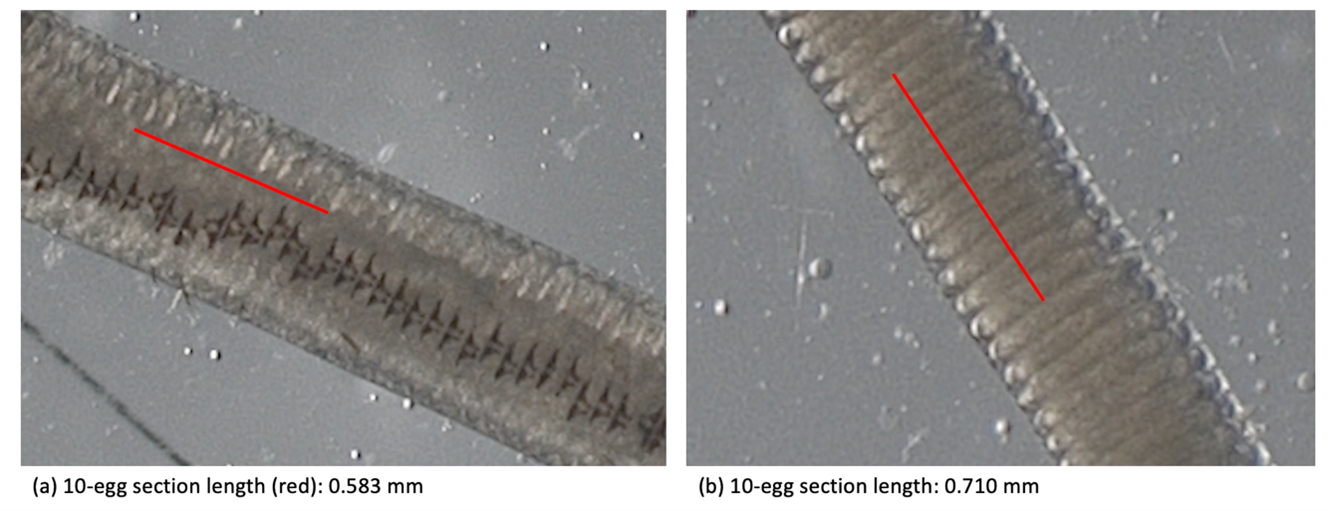Sea lice Early Life Stages (SeaLiceELS)
The SeaLiceELS project generated datasets for sea lice morphometrics and larval development from individuals collected in Scottish aquacultural sites.
SeaLiceELS investigated critical stages of the lifecycle of the most problematic parasite in Scottish aquaculture, the sea louse Lepeophtheirus salmonis.
The reproductive potential and early life stages of sea lice are poorly understood and pose serious challenges in the field of aquaculture modelling, which is an increasingly valuable tool in environmental and fish farm management.
Sea Lice Biology - a focus on the larval stage and need to improve modelling of dispersal
Adult sea lice latch onto a fish host for the remainder of their lifecycle; females produce a long string filled with eggs that remains attached until hatching.
The number of eggs is highly variable, and the number of larvae produced in a reproductive cycle is still a topic of active research.
The larvae represent a “black hole” in our knowledge of sea lice biology: once hatched, they are released into the water column to be dispersed by the currents.
Activities and results
Collected eggstrings were measured and then incubated in a custom-built nursery aquarium until hatching.
Once the larvae hatched, their number, state, and developmental phase were monitored; parallel to daily counts, the metabolic rate and activity levels of the larvae were measured through respirometry, video tracking, and activity logging.
The average number of eggs produced by individual female sea lice across several aquacultural sites was quantified, with no significant differences driven by location.
In contrast, the average length of the eggstrings varied considerably; this apparent discrepancy might be partly explained by the fact that eggs tend to occupy less space as the eggstring gets longer (they are effectively “squeezed” together).
All other morphometrics, such as the length and width of different body segments (cephalothorax, abdomen, and genital segments) showed strong differences across many sites. Since the history of the sea lice and the conditions that they developed in are unknown, it is not possible to link this variability in body measurements and the relative uniformity of egg production to specific causes.
The larvae that hatched were on average less than half of total egg numbers. Around half of the initial number of individuals successfully developed into copepodids, the stage in which the larvae become highly active swimmers and represent a threat of infection to fish.
Behavioural experiments confirmed that the infective stages of sea lice are extremely active compared to plankton species of the same family; considering their small size (0.5 mm), they consumed large amounts of oxygen and appeared to swim continuously over their entire time of survival, without any trigger in the form of light or other stimuli. Copepodids were also video tracked in a tank under light and dark conditions; this experiment revealed that they are able to cover the equivalent of several times their body size in one second, and can sustain short bursts of speed for several seconds.

Since tracking the 0.5 mm long larvae in the wild is a complex task, modelling techniques based on hydrographic systems have been adopted by the scientific community to better understand their potential movements. However, these models must be tuned to real, empirical data that can only be obtained by observing the lifecycle and reproductive output of the organism
Some of the most pressing questions in this field are related to the number of larvae that an individual louse can produce per reproductive cycle, the development time of the larvae into the infective stages, and individual variability.
The project generated datasets for sea lice morphometrics and larval development from individuals collected in Scottish aquacultural sites but also raised a number of questions for future research.
For more information contact: Helena Reinardy